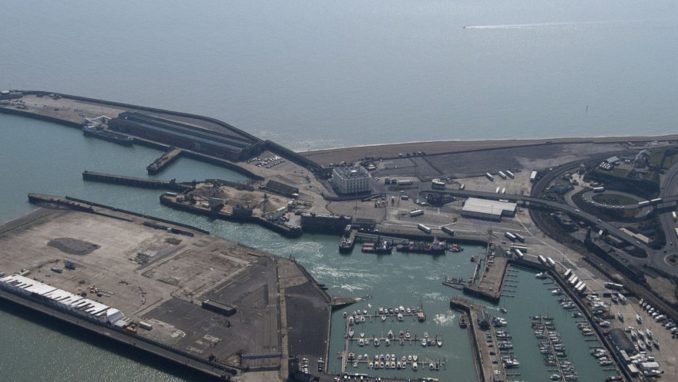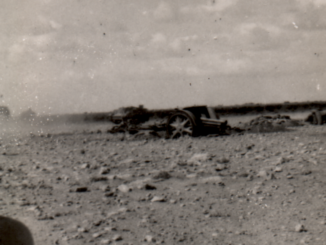
While going through all my father’s bits and pieces, which have been boxed up since his death, I came across a four page type-written reminiscence of the time he was stationed in Dover between 1940-41. I believe he typed it soon after he retired, back in 1982. I have transcribed the memoir as he wrote it, just correcting any typos.
I with five other members of ‘B’ Coy were sent to Dover to be on attachment to the Royal Navy’s shore station, “HMS Wasp”; this being a hotel named The Lord Warden, situated at the head of the eastern arm of Dover Harbour, the railway terminus for the Boat Train ferries which left for France. Our task was to help with the Navy’s shortage of sick berth attendants, filling in as medics on the Air Sea Rescue launches that were tied up alongside the harbour wall, which ran parallel with the railway lines. We were informed that our task was to be on board whichever craft was ordered out to sea, no matter the time of day. The hotel was run as a ship at sea; the pipes sounding out, preceding all messages that came from the tannoy’s loudspeakers. We were assigned a Mess to eat in and were required to help with all the various chores that came with it. We had a cabin, one of the hotel’s bedrooms and, instead of army boots we had to wear our gym shoes. On being allowed out into the town, we had to wait for the Liberty boat crew to be mustered. It seemed so strange for us army men.
Referring to the launches, they all had numbers painted on their hulls. Over the tannoy loudspeakers would come ”now hear this, now hear this – away 123”, or some such number and away would dash the crew with one of us medics in tow; out and across the railways lines and jump or scramble aboard the launch tied alongside the harbour wall, the engines already roaring into life. Then away out to sea, crossing the harbour. Meanwhile, our naval signalman would be flashing the Signals Station in the cliffs to allow us to proceed out of the harbour; having to pass all the sunken ships that lay in our path, with just their masts or superstructure showing above the water. The launches were sent out to sea whenever dogfights took place in the skies. The task of the rescue launch was to proceed to an allotted station in the Channel and wait for any report of a pilot having to bail out over the sea. The launch could be on station for some hours.
One incident that happened when I was aboard a craft – we were on station in mid-channel, watching the vapour trails overhead as both British and German fighter planes chased each other across the sky, hearing the sound of machine guns chattering away and the noise of aircraft diving and zooming up into the clouds. It was a bright and fairly calm day and we were all up on deck sitting, drinking hot mugs of cocoa, when all of a sudden out of the sun came this German fighter plane, which dived straight for us. The pilot levelled out at no more than fifty feet above the waves, banked around us, (we could plainly see him – we all thought this was it….), then he zoomed away up into the clouds and over to France. It must have looked very funny to him, seeing us all frozen with mugs of cocoa to our lips, staring up at him.
On another occasion, we were despatched out to sea to inspect one of the floating rescue buoys anchored in the Channel. They were for the use of any airman who had bailed out over the sea, who could then swim or paddle to it and climb the small iron ladder and open the metal door to a tiny compartment, which allowed him to sit or crouch down. Inside were blankets, self-heating cans of soup, first aid kit and a homing signal and flares. To approach one of these buoys, the launch had to slowly cruise round the buoy for a while, using the loudhailer, to make sure that the occupant was an RAF pilot. Some of the launches in the early days had been fired upon by German airmen who had taken refuge, while awaiting an E-Boat rescue.
Soon afterwards, I was moved from the Lord Warden to an MI Room on the harbour wall, near to where all the local Naval mine layers and sweepers were berthed. Back once more into the Army – the MI Room was used for the Gunners who manned the heavy ack ack batteries on the harbour walls and around the town of Dover. The MO was a Capt. Good RAMC, a refugee Jewish doctor from Austria. He spoke with a heavy accent and had been a specialist in his own country dealing with back problems. In this MI Room we had sick parades for Gunners who were suffering from back problems, due to working on the guns. My task was in helping the MO with paperwork; also, to make drawings of the patient’s back torso. This was to help Captain Good mark the area that had the most pain, then again mark the patient’s back, which he called the Myalgic spot. He would then inject the spot with Novocain, a local anaesthetic.
One night, the MO and I were called out to attend a suicide that had taken place in one of the barrack rooms on the breakwater arm of the harbour. We set out in the picket boat to cross the harbour, with a full tide running and when we arrived at the breakwater arm, the swell was rising and falling as much as twelve feet. As we came level with the top of the wall a voice shouted, “Jump”. You certainly made sure you landed on the wall, where willing hands grabbed you. We were taken to the barrack room where the suicide had taken place; all very sad, for the gunner had fixed his rifle on the bed to his head, with string leading from the trigger to his hand. Our job was to certify that the soldier was dead.
Again, I was on the move; having to leave the MI Room and to report to my CO, Major Little, who was the SMO Dover. His HQ was an office situated in the tunnels under Dover Castle, in the heart of the operations rooms, liaising with all the services in the Dover area. From here I was told to report to the Major in charge of the underground hospital, to help the surgeon in the small operating theatre and ward which had been built and to receive casualties for treatment as they arrived from either shelling or bombing.
Reaching the hospital, which had been tunnelled out of the cliff in the area by the keep and the outbuildings, the entrance was on the roadway that wound round the inner part of the castle. The tunnel lead downwards to the main area of the hospital and the walls and roof were curved for all the world like the London Underground. All had been cemented and painted white except the floors, they were bare cement. Walking down along this tunnel from the road to the main part of the hospital, it took a sharp turn. This was to counter any blast from outside. Around the corner was the reception area, with the MO’s room to one side. Opposite was the sterilizing room, where the instruments were boiled. Continuing on down was the theatre, not very large, containing a folding operating table set in the middle, a sink with running water on the side wall and an instrument trolley etc. Above the table, a small cluster of lights. It was in here that the anaesthetic was administered, using the mask with chloroform and ether. The theatre opened into the ward, which contained twenty beds army issue. The lighting for the ward was lamps with shades, spaced along the ceiling; the whole hospital being very basic.
On occasions when the German long-range guns were firing into the shipping passing through the Channel, some shells would fall onto the town itself. One day in particular, a salvo landed in the town square, causing some deaths and casualties. It was then the hospital sprang into action, using the theatre for both civilian and service personnel; working more as a Field Dressing Station. For, as soon as the shelling stopped the injured were transported to Canterbury. On days when the whole of Dover was covered in a thick sea mist and with the Castle standing out in the clear morning light – over would come the German fighter aircraft, swooping over the town and firing at all the Barrage Balloons floating above in the clear sky. It was a strange sight to see them all going up in flames. By the time the anti-aircraft guns had opened fire, the German aircraft were half-way across the Channel back to France.
Off-duty personnel were allowed to go into Dover and this meant that all service personnel had to carry their steel helmets at all times in the town. The order was that the chin strap of the helmet was looped through the epaulette on the left shoulder of the battle dress blouse and to make sure everyone obeyed this order; the Red Caps patrolled the streets. In off-duty periods, everyone made for the Old Town, which was down by the harbour and boasted two theatres, a cinema and various church canteens – the most popular being the Salvation Army, whose prices were so cheap and the food always piping hot and served by lassies laughing and joking with all the troops. Nearby was what was called the Garrison Theatre and here they staged rather risqué shows. It was always packed and when the sirens sounded for an air raid, or shelling alert, the manager would put on all the house lights, come to the front of the stage by the footlights and tell us all to leave. Of course, he was howled down with cat calls, booing and whistles. The noise was deafening and after a while he would relent, and the show would go on. This happened one night when “Phyllis Dixie” was on stage, performing the classic act of the Fan Dance and the one with Birds covering her….
Night-time was the most daunting part of all in the black-out, with the climb back up a very steep path to the Castle. On reaching the Castle walls, you were either winded or plain sober and then had to find your way along by the moat to the sandbagged drawbridge; this being the only way in at night. On the Castle side of the drawbridge, sentries with loaded rifles challenged with the words “Halt, Who Goes There?” and if you didn’t reply quick enough, they would slam in the bolt and drop the safety catch. Once across the drawbridge you were stopped and a light shone into your face, then into the guard room, groping for the entrance, to be met by the guard commander asking for your name and number.
Fld Amb = Field Ambulance
MI = Medical Inspection
SMO = Senior Medical Officer
© TonyB 2019
The Goodnight Vienna Audio file



